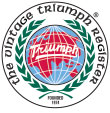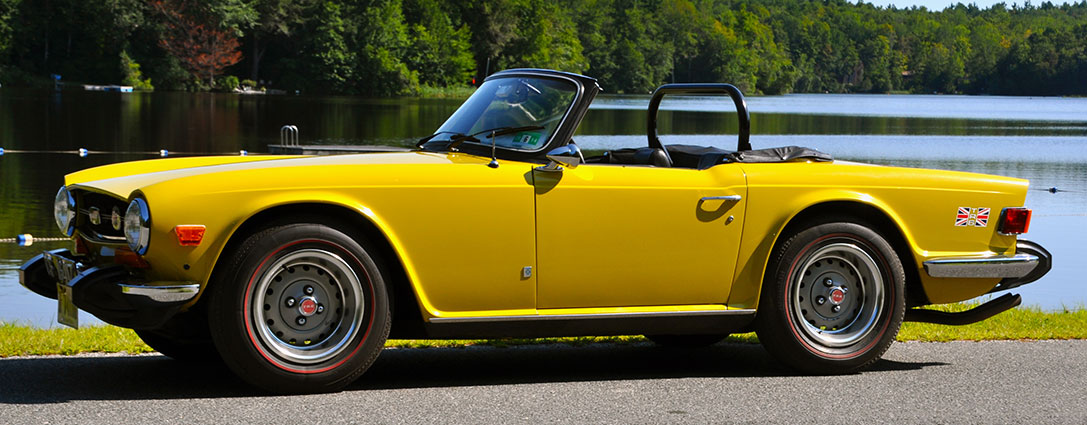
TR6
(1969-1976)
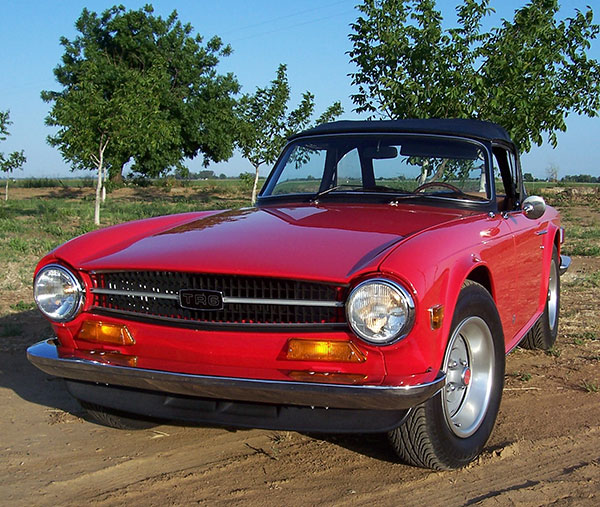
The Most Popular Everyday Transport
The TR6 ranks among one of the most popular British cars for modern everyday transport. The TR6 was introduced in 1969 with a re-skinned body versus the prior TR5/250 . More TR6s were produced by Triumph than any prior TR: over ninety thousand were sold before the TR6 was replaced by the TR7 in 1976. With the optional hardtop , the TR6 makes an excellent “Grand Touring (GT)” coupe.
A History of the TR6
Collected from Various Sources
The TR6 was introduced in January, 1969, using similar chassis and running gear components to those used in the TR5/TR250. However, the body work, while retaining some elements of the TR5/TR250 design, was externally restyled by Karmann. Apart from smoothing the lines of the car, the design changes also gave the car more boot space. A front anti-roll bar now formed part of the specification and wider wheels were also fitted making the car look low, lean and very fast – which, of course, it was, courtesy of the TR5/TR250 smooth 6-cylinder inline 2498cc engine.
The powerful six-cylinder engine is a reliable until, whether with UK-market petrol injection (150bhp) or US-market carbureted (104 bhp) fuel delivery. The UK petrol intected version was de-rated to 125 bhp in 1973 by by camshaft alterations and revised fuel injection metering. These changes made the TR6 smoother and more flexible.
The TR6 was modified in several respects during its production run and the components affected include the gearbox (ratios) and the optional overdrive (type). The trim was also altered and an air dam was fitted below the bumper from 1973.
A useful option on the TR6 was the one piece detachable steel hardtop which easily converted the car to a neat sports coupe.
The TR6 came to the end of its production in July 1976 (February, 1975 for UK-maret models). In all, 94,619 TRs were built, of which 86,249 found homes overseas, only 8,370 being sold in the UK.
The car retained the appeal of traditional British sports models but had the additional, exciting element of being faster and more furious than many would-be rivals. This combination of tradition and power helps to explain its popularity today.
The two seats are comfortable and there is ample leg room. The trim is functional, rather than fancy. The facia is neat and uncluttered, an endearing feature of most 1960s Triumphs. The wooden facia gives an air of quality. The rear end styling of the Karmann body work is as neat as that at the front, with flowing lines which incorporate the tail lamp units and rear bumpers. The luggage compartment is very roomy for that of a two-seater sports car and an improvement on the boot of earlier TRs. The extended body line gives greater capacity.
The TR6 – the consummation of the original TR line (the TR7 was a completely new model) – is an attractive, fast and very enjoyable two-seater. Its fine performance, good road holding and relative reliability, plus its sheer character, make it a car which is a joy to be driven by the current enthusiast!
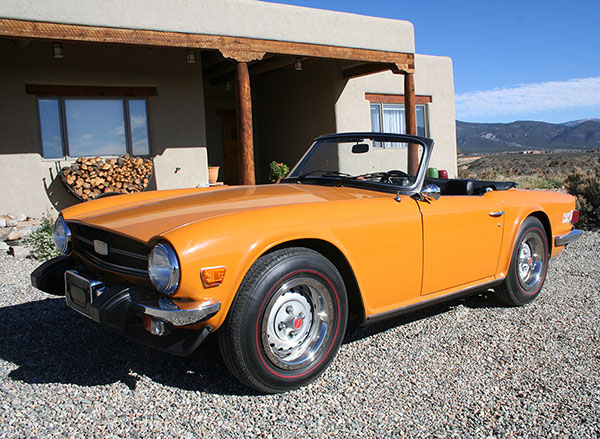
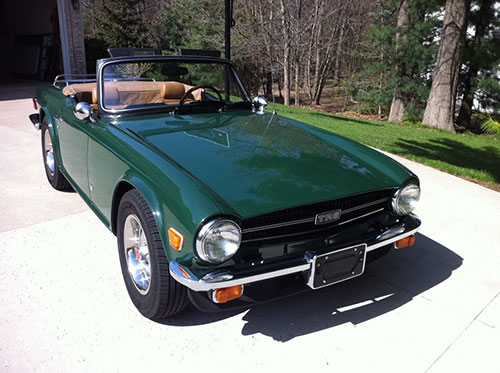
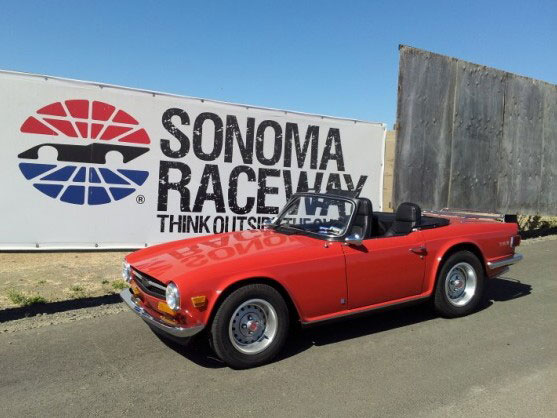
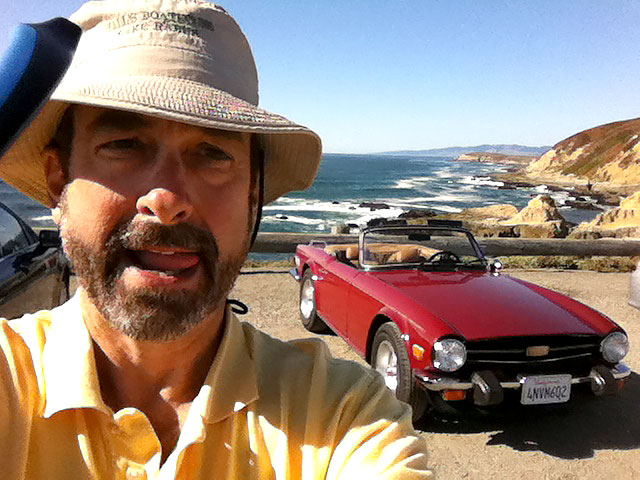
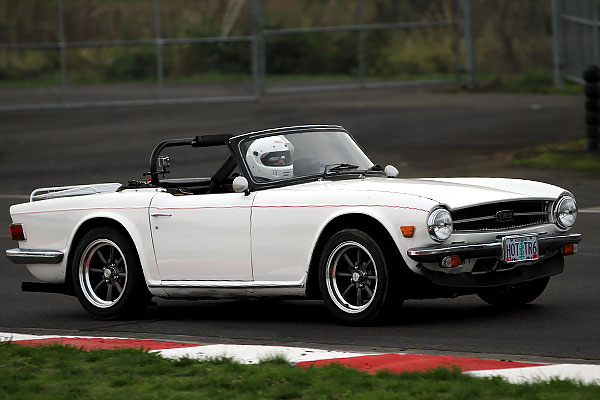
TR6 Spotter’s Guide
- 9/19/68, first prototype TR6 CP25001.
- Karmann restyles body, using main substructure of the TR4/250
- 5 1/2″ wheels replace the 5″ version of TR4a
- Provision made for front anti-roll bar.
- Twin carbs in U.S.A., P.I. in U.K.
- CP25003, first carb TR6 on record, build 9/19/68
- Rostyle wheel covers standard.
- First year of production
- TR4 type 16P brake caliper replaced with 16B type.
- Black spoked steering wheel with pierced holes.
- Chromed valve cover.
- Windshield surround in body color.
- Laycock de Normanville A-type overdrive carried over with TR250 gearbox.
- Rostyle wheel covers standard to CC50000.
- Seats feature “breathing material”.
- New disc wheel with 15 hole pattern.
- Painted valve cover replaces chromed version.
- New inlet manifold on carb cars.
- Steering lock introduced on export cars.
- Ignition switch moved from dash to under column.
- Windshield surround now black regardless of body color.
- 72 spoke wire wheels still offered although they receive little mention.
- New steering wheel with silver anodized spokes replaces black spoked wheel.
- Stag type gearbox parts used.
- 7 blade fan replaces 8 blade at CP52420.
- Square reflectors under tail lamps (U.S.A only)
- Compression dropped from 8.5:1 to 7.75:1.
- New exhaust system. Twin exhaust downpipe for carb cars.
- Gas tank capacity reduced to 10.25 gallons.
- Rear springs and wishbones brackets uprated late 1971.
- Grease nipple on propshaft deleted.
- Brake caliper changed again, now incorporate metric threads.
- Major U.S.A. restyle.
- Black plastic air dam introduced.
- J-type overdrive introduced; overdrive on 3rd and 4th only.
- New steering wheel and instruments including “inverted” small gauges.
- Union Jack decal replaces TR6 logo on rear fender.
- Air intake flap on cowl replaced with plastic grill.
- Voltmeter replaces ammeter.
- Commission plate moved to left hand doorpost.
- Wire wheel option ends in May.
- Flat black wiper arms replace chromed versions.
- New interior trim includes center door pull.
- Chestnut and Beige trim offered in fire-resistant material.
- Full tonneau cover now standard.
- Rubber bumper overiders introduced to U.S.A market to meet federal regulations. (Late 1974)
- Front bumper raised.
- Amber/white indicator lamps moved under bumper.
- Air injection system introduced.
- Triumph styled hardtop continues to sell well until end of production.
- Last P.I. TR6 built on 2/7/75.
- Front indicator lenses amber.
- Last TR6 built on 7/15/76, CF58328.
- Some 1976 TR6s were sold in 1977 and may be registered as such.
Member Pages
Mike Brinker | Michigan
Bob Danielson | Connecticut
Shane Ingate | California
Jeff Lampinski | Pennsylvania | Photos of restoration process
Tom Smith | Wisconsin
If you would like your page added to this listing, please contact the webmaster.
Production Dates and Numbers
The Triumph TR6 was produced from 1969 until 1976.
With 91,850 TR6s manufactured over these 8 years of production, more TR6s were produced than any prior TR model.
The detailed production information follows:
| Year | Chassis Numbers | # Produced |
| 1969 | CC25000 to CC32141 | |
| 1970 | CC50001 to ?? | |
| 1971 | ?? to CC67893 | |
| 1972 | CC75001 to CC85737 | |
| 1973 | CF1U to CF12500U | |
| 1974 | CF12501U to CF25777U | |
| 1974 ½ | CF27001U to CF35000U | |
| 1975 | CF35001U to CF39991U | |
| 1976 | CF50001U to CF58328U |
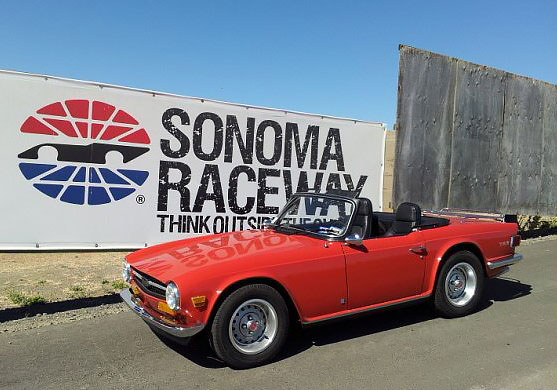









TR6 Buyer’s Guide
In addition to the items listed in the general Triumph Buyers Guide , there are a number of specific items of interest on the TR6.
Parts availability for the TR6 is excellent, with a number of major suppliers providing most parts for the TR6, ranging from tune up components and interior kits to complete body shells.
Potential TR6 Problem Areas:
Body: One of the most important things to watch for on the TR6, as with all Triumphs, is rust. Rust coming through the paint generally indicates that there is 5 to 10 times more rust lurking beneath the body panels. Where does one look for rust on a TR6, other then everywhere?
- The top of rear deck at the seams between the deck panels and fenders. Even slight bubbling of the paint in this area may be indicative of more serious rust deeper within the seams.
- Under the carpets at the front of footwells, underneath the driver’s pedals, and along the seat rails.
- On the front quarter panels behind the wheels, particularly at the junction with the firewall.
- Behind the rear wheels, all the way back to the rear valence, around the tops of that portion of the taillight which wraps around the side of the fender. Remember to check the *inside* of these panels as well as the outside.
- In the engine compartment around the battery box, and under the hydraulic master cylinders, where leaking fluids may have removed paint, allowing rust to spread.
Frame: The TR6 frame is a boxed section frame with baffles that separate the long sections. The most common problem with these frame members is that salt and water can easily get inside the frame member and rot it from the inside out. The problem first shows up a “blisters” along the seams where the frame sections join together. Two particular special problem areas are where the trailing arms (for the rear suspension) and differential are attached to the frame. Look very carefully at the location that the trailing arms mount to the frame. Very easy to get to, it’s just behind the seats, and underneath the car. If there is rust on these pieces, get up, dust yourself off, and say ‘Thanks, but no thanks’. (Unless you are looking for a donor car for a major project.) Repairing/replacing these sections is very time and labour intensive, usually requiring a body off repair or a new frame to fix it “right.” If you drive the car, listen for telltale clunks coming from torn diff mounts, although these “clunks” sounds a lot like simple worn U-joint noise. Yet another frame/body warning sign are problems with sagging sills and doors that are tough to open/close.
Electricals: There are no particularly unusual electrical problems on the TR6, other than the typical problems common to nearly all British cars.
Mechanicals: In general, the TR6 drivetrain is pretty solid and robust. Lots of mechanical parts are available for the TR6, from numerous suppliers. Some of the more common mechanical problems that may cost you more than you expected include:
Differential: The bearings are ball bearing type. They can fail. Failure often results in major differential failure that is remedied by replacing the diff. Also the ring and pinion can break for any number of reasons (not the least of which would be smokey burnouts :-() Rebuilding TR6 diffs requires special tools too. Farm the work out.
Engine: The TR6 engine is pretty strong, and can go long without any major overhaul. When they start to get tired, they can be easily reconditioned by a competent overhauler. If the current owner said that he/she rebuilt it, do not consider the engine overhaul to contribute to the overall value of the car. The sole exception to this rule is that if the mechanic is/was a real TR mechanic. The most informative thing you can learn about a TR6 engine if you can’t actually run it is to check the condition of the Thrust Washers. These are the biggest failure point. Replacement can require a different crankshaft and block if the condition is severe enough. This can be a good bargaining point when buying a TR6. To check, simply push the crankshaft pulley rearward as hard as you can, then have an assistant sit in the car. Now, use your hand to span the space between the crank pulley and the front of the engine, and inform your assistant to lightly step on the clutch pedal. You’ll feel the crank pulley move forward slightly, and this will reveal the condition of the thrust washers. The allowable axial play for the crankshaft is .007-.013 If the distance seems greater than say, the thickness of your fingernail, you should bargain for a lower price, knowing that you’ll have to be into the lower end of the motor soon. If the distance approaches 1/8″, you can bet that the thrust washers have fallen into the oil pan, and the connecting rod bearings are short to fail. In this case, a different engine would probably be in order.
Front end: the front end on a TR6 is pretty strong. Most of the parts are relatively easy to replace given time and patience.
Rear Hubs: The rear hubs are a common malady. The bearings for the rear hubs are sealed bearings (in a sense.) There is no way to lubricate them, and they can fail for a number of reasons. At any rate, if you catch them early (when they start to slop a bit) then you can get them rebuilt by a competent shop (with experience!) or mail-order British car specialist. If you don’t catch them in time…it’s in the bin with them! Expensive! Don’t try to fix them yourself, or you will repeat the story that a lot of TR6 owners tell of a shop that wrecked a set of hubs. There are special tools required to do the hubs right as well as above average mechanical skills. Farm out hub rebuilding!
Transmission: The transmissions on TR6s are pretty good. If they make noise in any gears, the overhaul can be expensive. It a transmission in a prospective purchase has been rebuilt, if the current owner rebuilt it, do not consider this piece in the overall value of the vehicle. Also, make sure that all gears shift smoothly. Bad synchros and slop in the shift mechanism can make the best transmission beat itself to death in very short order!
U-joints: There are six U-joints on the TR6. The factory installed units were permanently lubricated. This means that they fail after a while. If they have been replaced, they might have grease nipples which if used to grease the u-joints will aid in longevity.
Prices
TR6 prices really do not vary much from model year to model year. Some people prefer the earlier car with the higher compression engine and “clean” bumpers. Others prefer the later car with the better intake manifold, dual exhaust, bumper guards (necessary for any regularly used car), front spoiler, comfier seats, and Union Jack flags. Personally, I have one of each and prefer different things about the early and late cars.
The one exception to this would be the very earliest cars (say the first 100 or so) and the very last ones (last 100 or so), which would be worth a premium due to their “uniqueness.” 1969 cars are somewhat rare, and may fetch a very little bit more (5%?) than other years for the same condition car, but are a bit of a pain to maintain, as they have a few minor bits and pieces which weren’t used the other years. Other than that, however, TR6 prices are quite flat across the years.
To some extent, however, the features that are most desirable vary a lot according to the person and how they plan to use the car, so the demand is pretty much flat across the whole production range, as each year had some strengths and disadvantages.
By far the most significant factor in car price is the condition of the car. The year of the car is way down on the list of determining factors, below things like body and trim color. Hardtop , overdrive, and AC each add about 5% to the price of a car at any given condition. The April ’94 issue of “British Car” includes a Triumph TR6 price guide: (reprinted here without permission, so please don’t include this in a hardcopy newsletter without permission) Triumph places have been flat over the past few years, so these prices are still accurate as of this writing. (August 1997)
| CONDITION ———————————— Restored – 100% as new, 95 points min concourse Excellent – mostly restored or superb original Amateur partly restored, or very good original Good, complete, runs and drives well Fair, drivable, needs minor repairs, but complete Poor, not too incomplete, not badly rusted/damaged Poor, rough, incomplete, damaged, or badly rusted |
Price —— $12,000 $9,000 $6,250 $4,000 $2,300 $1,200 $700 |
Remember, these are values based on a normal (non duress) situation. If you are trying to sell a TR6 (or any collector car for that matter) in a hurry (i.e. divorce settlements, need immediate cash to close on the new house, etc.) then prices can be lower, especially in winter months in the northern states. Also price valuations are usually given to estimate the cost of replacement.
